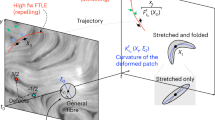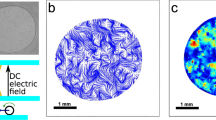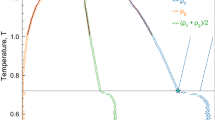Abstract
Elongated active units cannot spontaneously break rotation symmetry in bulk fluids to form nematic or polar phases. This has led to the image of active suspensions as spontaneously evolving, spatiotemporally chaotic fluids. Here, in contrast, I show that bulk active fluids have stable active nematic and polar states at fluid–fluid or fluid–air interfaces. The active flow-mediated long-range interactions that destroy the ordered phase in bulk lead to long-range order at the interface. Thus, active fluids have a surface ordering transition and form states with quiescent, ordered surfaces and chaotic bulk. I further consider active units that are constrained to live at an interface to examine the minimal conditions for the existence of two-dimensional order in bulk three-dimensional fluids. In this case, immotile units do not order, but motile particles still form a long-range-ordered polar phase. This prediction of stable, uniaxial, active phases in bulk fluids may have functional consequences for active transport.
This is a preview of subscription content, access via your institution
Access options
Access Nature and 54 other Nature Portfolio journals
Get Nature+, our best-value online-access subscription
$29.99 / 30 days
cancel any time
Subscribe to this journal
Receive 12 print issues and online access
$209.00 per year
only $17.42 per issue
Buy this article
- Purchase on Springer Link
- Instant access to full article PDF
Prices may be subject to local taxes which are calculated during checkout




Similar content being viewed by others
Data availability
No datasets were generated or analysed during the current study.
Code availability
No custom code was used in the current study.
References
Ramaswamy, S. Active matter. J. Stat. Mech. 2017, 054002 (2017).
Dadhichi, L. P., Maitra, A. & Ramaswamy, S. Origins and diagnostics of the nonequilibrium character of active systems. J. Stat. Mech. 2018, 123201 (2018).
Marchetti, M. C. et al. Hydrodynamics of soft active matter. Rev. Mod. Phys. 85, 1143–1189 (2013).
Prost, J., Jülicher, F. & Joanny, J.-F. Active gel physics. Nat. Phys. 11, 111–117 (2015).
Jülicher, F., Grill, S. W. & Salbreux, G. Hydrodynamic theory of active matter. Rep. Prog. Phys. 81, 076601 (2018).
Ramaswamy, S. The mechanics and statistics of active matter. Annu. Rev. Condens. Matter Phys. 1, 323–345 (2010).
Simha, R. A. & Ramaswamy, S. Hydrodynamic fluctuations and instabilities in ordered suspensions of self-propelled particles. Phys. Rev. Lett. 89, 058101 (2002).
Voituriez, R., Joanny, J.-F. & Prost, J. Spontaneous flow transition in active polar gels. Europhys. Lett. 70, 404 (2005).
Alert, R., Joanny, J.-F. & Casademunt, J. Universal scaling of active nematic turbulence. Nat. Phys. 16, 682–688 (2020).
Alert, R., Joanny, J.-F. & Casademunt, J. Active turbulence. Annu. Rev. Condens. Matter Phys. 13, 143–170 (2022).
Maitra, A. et al. A nonequilibrium force can stabilize 2D active nematics. Proc. Natl Acad. Sci. USA 115, 6934–6939 (2018).
Maitra, A., Srivastava, P., Marchetti, M. C., Ramaswamy, S. & Lenz, M. Swimmer suspensions on substrates: anomalous stability and long-range order. Phys. Rev. Lett. 124, 028002 (2020).
Sarkar, N., Basu, A. & Toner, J. Swarming bottom feeders: flocking at solid-liquid interfaces. Phys. Rev. Lett. 127, 268004 (2021).
Sarkar, N., Basu, A. & Toner, J. Hydrodynamic theory of flocking at a solid-liquid interface: long-range order and giant number fluctuations. Phys. Rev. E 104, 064611 (2021).
Sluckin, T. J. & Poniewierski, A. Novel surface phase transition in nematic liquid crystals: wetting and the Kosterlitz-Thouless transition. Phys. Rev. Lett. 55, 2907–2910 (1985).
Langer, S. A., Liu, A. J. & Toner, J. Hydrodynamics of two-dimensional smectics on fluid surfaces. Phys. Rev. Lett. 70, 2443–2446 (1993).
Binder, K. & Hohenberg, P. C. Phase transitions and static spin correlations in Ising models with free surfaces. Phys. Rev. B 6, 3461–3487 (1972).
Lubensky, T. C. & Rubin, M. H. Critical phenomena in semi-infinite systems. I. ϵ expansion for positive extrapolation length. Phys. Rev. B 11, 4533–4546 (1975).
Lubensky, T. C. & Rubin, M. H. Critical phenomena in semi-infinite systems. II. Mean-field theory. Phys. Rev. B 12, 3885–3901 (1975).
Poniewierski, A. & Sluckin, T. J. Statistical mechanics of a simple model of the nematic liquid crystal-wall interface. Mol. Crys. Liq. Crys. 111, 373–386 (1984).
Perlekar, P., Benzi, R., Nelson, D. R. & Toschi, F. Population dynamics at high Reynolds number. Phys. Rev. Lett. 105, 144501 (2010).
Lopez, D. & Lauga, E. Dynamics of swimming bacteria at complex interfaces. Phys. Fluids 26, 071902 (2014).
Sanchez, T., Chen, D. T. N., DeCamp, S. J., Heymann, M. & Dogic, Z. Spontaneous motion in hierarchically assembled active matter. Nature 491, 431–434 (2012).
Martínez-Prat, B., Ignés-Mullol, J., Casademunt, J. & Sagués, F. Selection mechanism at the onset of active turbulence. Nat. Phys. 15, 362–366 (2019).
Senoussi, A. et al. Tunable corrugated patterns in an active nematic sheet. Proc. Natl Acad. Sci. USA 116, 22464–22470 (2019).
Strübing, T. et al. Wrinkling instability in 3D active nematics. Nano Lett. 20, 6281–6288 (2020).
Gao, T., Blackwell, R., Glaser, M. A., Betterton, M. D. & Shelley, M. J. Multiscale modeling and simulation of microtubule-motor-protein assemblies. Phys. Rev. E 92, 062709 (2015).
Gao, T., Blackwell, R., Glaser, M. A., Betterton, M. D. & Shelley, M. J. Multiscale polar theory of microtubule and motor-protein assemblies. Phys. Rev. Lett. 114, 048101 (2015).
Subbiahdoss, G. & Reimhult, E. Biofilm formation at oil-water interfaces is not a simple function of bacterial hydrophobicity. Colloids Surf. B 194, 111163 (2020).
Zutic, V., Ivosevic, N., Svetlicic, V., Long, R. A. & Azam, F. Film formation by marine bacteria at a model fluid interface. Aquat. Microb. Ecol. 17, 231–238 (1999).
Vaccari, L., Molaei, M., Leheny, R. L. & Stebe, K. J. Cargo carrying bacteria at interfaces. Soft Matter 14, 5643–5653 (2018).
Niepa, T. H. R. et al. Films of bacteria at interfaces (FBI): remodeling of fluid interfaces by Pseudomonas aeruginosa. Sci. Rep. 7, 17864 (2017).
Chaudhuri, A., Bhattacharya, B., Gowrishankar, K., Mayor, S. & Rao, M. Spatiotemporal regulation of chemical reactions by active cytoskeletal remodeling. Proc. Natl Acad. Sci. USA 108, 14825–14830 (2011).
Goswami, D. et al. Nanoclusters of GPI-anchored proteins are formed by cortical actin-driven activity. Cell 135, 1085–1097 (2008).
Mayor, S. & Rao, M. Rafts: scale-dependent, active lipid organization at the cell surface. Traffic 5, 231–240 (2004).
Gowrishankar, K. et al. Active remodeling of cortical actin regulates spatiotemporal organization of cell surface molecules. Cell 149, 1353–1367 (2012).
Gidituri, H., Shen, Z., Würger, A. & Lintuvuori, J. S. Reorientation dynamics of microswimmers at fluid-fluid interfaces. Phys. Rev. Fluids 7, L042001 (2022).
Ahmadzadegan, A., Wang, S., Vlachos, P. P. & Ardekani, A. M. Hydrodynamic attraction of bacteria to gas and liquid interfaces. Phys. Rev. E 100, 062605 (2019).
Salbreux, G., Prost, J. & Joanny, J.-F. Hydrodynamics of cellular cortical flows and the formation of contractile rings. Phys. Rev. Lett. 103, 058102 (2009).
Toner, J. Birth, death, and flight: a theory of Malthusian flocks. Phys. Rev. Lett. 108, 088102 (2012).
Khandkar, M. D. & Barma, M. Orientational correlations and the effect of spatial gradients in the equilibrium steady state of hard rods in two dimensions: a study using deposition-evaporation kinetics. Phys. Rev. E 72, 051717 (2005).
Marenduzzo, D., Orlandini, E., Cates, M. E. & Yeomans, J. M. Steady-state hydrodynamic instabilities of active liquid crystals: hybrid lattice Boltzmann simulations. Phys. Rev. E 76, 031921 (2007).
Underhill, P. T., Hernandez-Ortiz, J. P. & Graham, M. D. Diffusion and spatial correlations in suspensions of swimming particles. Phys. Rev. Lett. 100, 248101 (2008).
da Gama, M. M. Telo. The interfacial properties of a model of a nematic liquid crystal. I. The nematic-isotropic and the nematic-vapour interfaces. Mol. Phys. 52, 585–610 (1984).
da Gama, M. M. Telo. The interfacial properties of a model of a nematic liquid crystal. II. Induced orientational order and wetting transitions at a solid–fluid interface. Mol. Phys. 52, 611–630 (1984).
Nakanishi, H. & Fisher, M. E. Multicriticality of wetting, prewetting and surface transitions. Phys. Rev. Lett. 49, 1565–1568 (1982).
Sheng, P. Boundary-layer phase transition in nematic liquid crystals. Phys. Rev. A 26, 1610–1617 (1982).
Ramaswamy, S., Simha, R. A. & Toner, J. Active nematics on a substrate: giant number fluctuations and long-time tails. Europhys. Lett. 62, 196 (2003).
Chaté, H. Dry aligning dilute active matter. Annu. Rev. Condens. Matter Phys. 11, 189–212 (2019).
Shankar, S., Ramaswamy, S. & Marchetti, M. C. Low-noise phase of a two-dimensional active nematic system. Phys. Rev. E 97, 012707 (2018).
Bertin, E. et al. Mesoscopic theory for fluctuating active nematics. N. J. Phys. 15, 085032 (2013).
Boffetta, G., Davoudi, J., Eckhardt, B. & Schumacher, J. Lagrangian tracers on a surface flow: the role of time correlations. Phys. Rev. Lett. 93, 134501 (2004).
Lee, S. H., Chadwick, R. S. & Leal, L. G. Motion of a sphere in the presence of a plane interface. Part 1. An approximate solution by generalization of the method of Lorentz. J. Fluid Mech. 93, 705–726 (1979).
Dörr, A., Hardt, S., Masoud, H. & Stone, H. A. Drag and diffusion coefficients of a spherical particle attached to a fluid-fluid interface. J. Fluid Mech. 790, 607–618 (2016).
Cai, W. & Lubensky, T. C. Hydrodynamics and dynamic fluctuations of fluid membranes. Phys. Rev. E 52, 4251–4266 (1995).
Martínez-Prat, B. et al. Scaling regimes of active turbulence with external dissipation. Phys. Rev. X 11, 031065 (2021).
Mahault, B. & Chaté, H. Long-range nematic order in two-dimensional active matter. Phys. Rev. Lett. 127, 048003 (2021).
Toner, J. Reanalysis of the hydrodynamic theory of fluid, polar-ordered flocks. Phys. Rev. E 86, 031918 (2013).
Chatterjee, R., Rana, N., Simha, R. A., Perlekar, P. & Ramaswamy, S. Inertia drives a flocking phase transition in viscous active fluids. Phys. Rev. X 11, 031063 (2021).
Lemma, L. M., DeCamp, S. J., You, Z., Giomi, L. & Dogic, Z. Statistical properties of autonomous flows in 2D active nematics. Soft Matter 15, 3264–3272 (2019).
Lemma, L. M. et al. Multiscale microtubule dynamics in active nematics. Phys. Rev. Lett. 127, 148001 (2021).
Guillamat, P., Ignés-Mullol, J., Shankar, S., Marchetti, M. C. & Sagués, F. Probing the shear viscosity of an active nematic film. Phys. Rev. E 94, 060602 (2016).
Maitra, A., Srivastava, P., Rao, M. & Ramaswamy, S. Activating membranes. Phys. Rev. Lett. 112, 258101 (2014).
Singh, R. & Cates, M. E. Hydrodynamically interrupted droplet growth in scalar active matter. Phys. Rev. Lett. 123, 148005 (2019).
Zwicker, D., Seyboldt, R., Weber, C. A., Hyman, A. A. & Jülicher, F. Growth and division of active droplets provides a model for protocells. Nat. Phys. 13, 408–413 (2017).
Acknowledgements
I thank Sriram Ramaswamy and Raphael Voituriez for insightful comments and discussions. I also thank Sriram Ramaswamy for his careful reading of the manuscript and for crucial suggestions. I acknowledge a TALENT fellowship awarded by CY Cergy Paris University.
Author information
Authors and Affiliations
Contributions
A.M. planned the research, performed the theoretical analysis, wrote the article and revised it.
Corresponding author
Ethics declarations
Competing interests
The author has no competing interests.
Peer review
Peer review information
Nature Physics thanks Sebastian Fürthauer and the other, anonymous, reviewer(s) for their contribution to the peer review of this work.
Additional information
Publisher’s note Springer Nature remains neutral with regard to jurisdictional claims in published maps and institutional affiliations.
Supplementary information
Supplementary Information
Supplementary Fig. 1 and Supplementary Discussion.
Rights and permissions
Springer Nature or its licensor (e.g. a society or other partner) holds exclusive rights to this article under a publishing agreement with the author(s) or other rightsholder(s); author self-archiving of the accepted manuscript version of this article is solely governed by the terms of such publishing agreement and applicable law.
About this article
Cite this article
Maitra, A. Two-dimensional long-range uniaxial order in three-dimensional active fluids. Nat. Phys. 19, 733–740 (2023). https://doi.org/10.1038/s41567-023-01937-4
Received:
Accepted:
Published:
Issue Date:
DOI: https://doi.org/10.1038/s41567-023-01937-4



